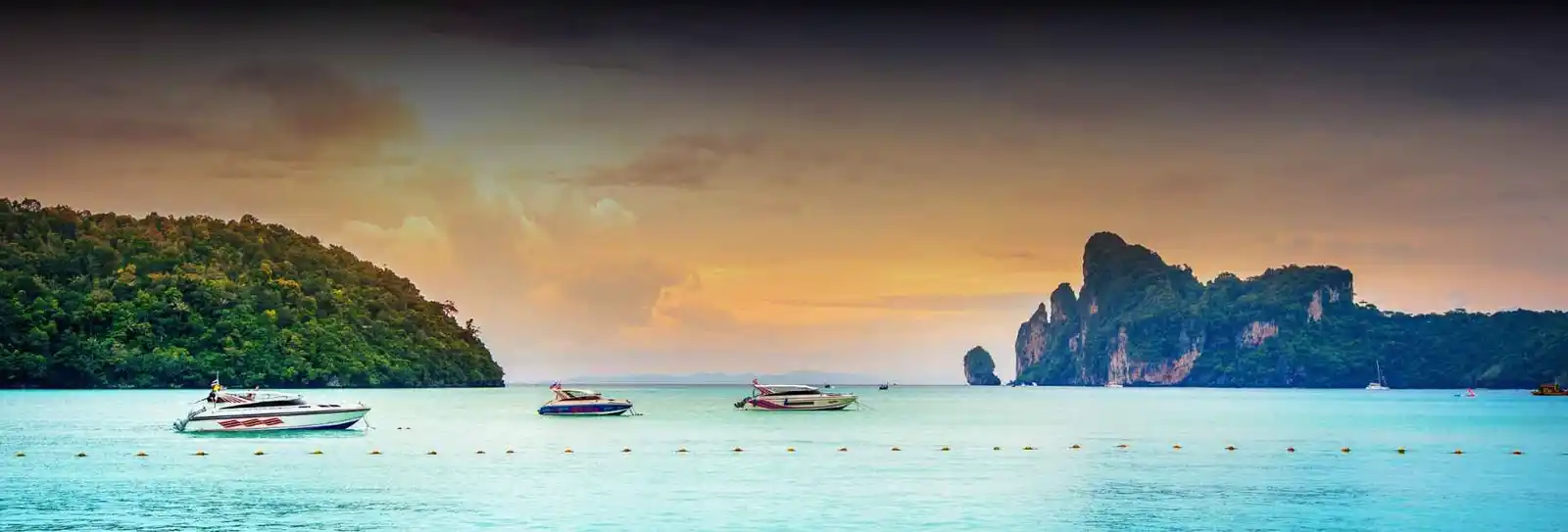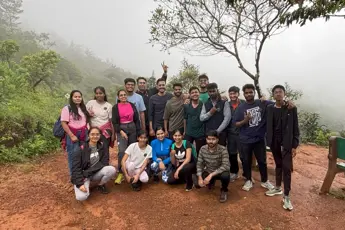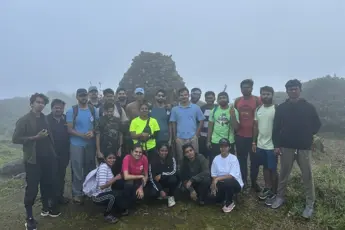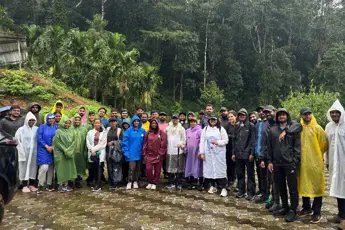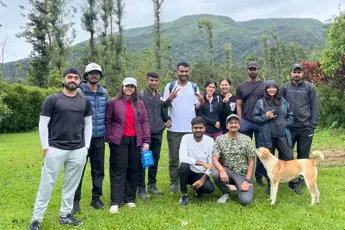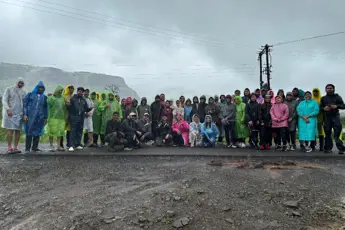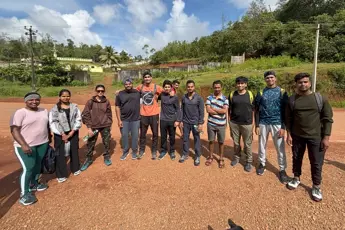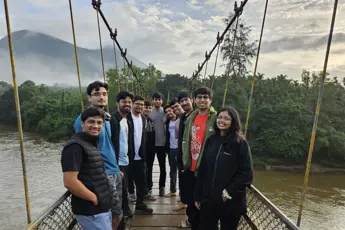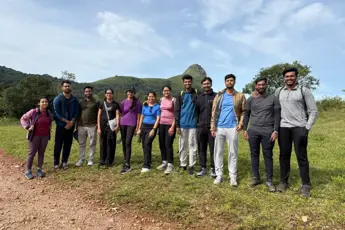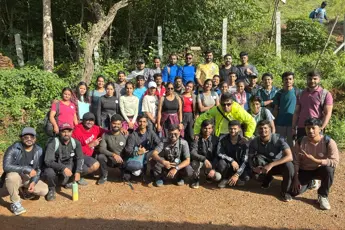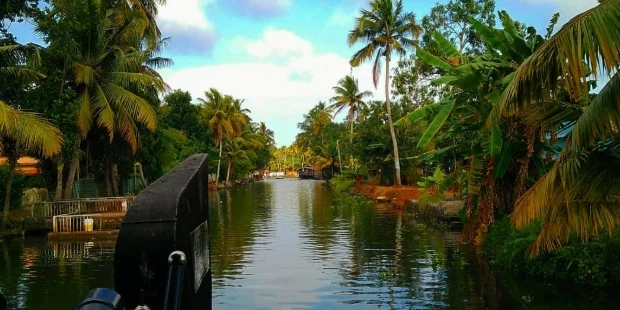
Kerala backwaters present a blissfully unforgettable experience of nature, culture, and peaceful solitude. The whole classy network of lake system, canals, and lagoons along the southwest coast of India running parallel to the Arabian Sea is presented to display an unparalleled ecosystem that has been enthralling travellers for a long time. Boating through these calm waters on houseboats is the ultimate experience to familiarise oneself with Kerala backwaters. As you sail through green rice paddies, rolling coconut groves, and villages, you observe daily life unfold before your eyes in its purest form: children waving from riverbanks, fishermen preparing their nets, and women washing clothes in the river. Alleppey (Alappuzha) is another favourite backwater spot and even the "Venice of the East." Even the kettuvallams, or the houseboats here, are equally well-furnished with everything the world has to offer, but with a rustic flavour.Kumarakom, which is a favourite haunt of tourists in general, is world-famous not only for its bird sanctuary but also for the luxury resorts overlooking the Vembanad Lake. For a quieter and more relaxed experience, destinations such as Ashtamudi and Kuttanad are available with fewer visited retreats where you can soak up the nation way of life. The local food provides an additional dimension to the experience as fresh Kerala-type food is prepared and consumed on banana leaves, for example, fish that was just caught. Cultural experiences, like watching traditional Kathakali dance shows or familiarising yourself with local artisans, provide substance to the experience.1.Alleppey (Alappuzha)Alleppey, also officially known as Alappuzha, is a scenic town in the state of Kerala in southern India. Nicknamed the "Venice of the East," Alleppey is famous for its long series of beautiful backwaters, peaceful canals, and green rice fields. Alleppey is one of Kerala's top spots for backwater tourism and houseboat cruises, giving the visitor an opportunity to see and enjoy the natural beauty and local lifestyle here.History of AlleppeyAlleppey is steeped in history and is one of those places that are famous for the strategic significance of trade and commerce. Maharaja Marthanda Varma of Travancore built the city as a seaport and trading town in the 18th century. The British built the canals and developed a port, further augmenting its significance. Alleppey was a coir trade and spice commerce centre earlier, and remnants of colonial architecture and godowns still dot the town's landscape.Top Things to Do in AlleppeyHouseboat Cruise: The most symbolic thing to do in Alleppey is to cruise on the backwaters aboard a vintage Kettuvallam (houseboat). Houseboats provide a serene and scenic ride along palm-fringed countryside and canals.Alappuzha Beach: This peaceful beach is ideal for sunsets and evening walks. The retro look is added by the old, 150-year-old pier jutting into the sea and the adjacent lighthouse.Paddle through the Backwaters by Canoe or Kayak: To see backwaters in air-conditioned comfort, paddle through thin channels, impossible for larger boats to access.Ambalapuzha Sri Krishna Temple: 14 km from Alleppey, this ancient temple is renowned for Palpayasam (milk porridge sweets) and Kerala architecture.Places to Visit Around AlleppeyKumarakom: 35 km away, Kumarakom is a backwater spot renowned for bird watching at the Kumarakom Bird Sanctuary.Marari Beach: Only 11 km from Alleppey, Marari is a tranquil beach ideal for leisure and relaxation walks along the Arabian Sea.Pathiramanal Island: A scenic island on Vembanad Lake, it's a heaven for nature lovers and bird watchers.Kuttanad: The "Rice Bowl of Kerala," Kuttanad, boasts below-sea-level cultivation and a humongous expanse of paddy fields.Best Time to Visit AlleppeyOctober to March: The most ideal time to visit is with pleasant weather. Ideal for houseboat cruising, sightseeing, and festivals.June to September (Monsoon Season): Scenic verdant green spots and most apt for Ayurvedic treatment. Rain adds a special taste to backwaters.April to May (Summer Season): Hot and humid, yet tourist-off-season, best time for budget travel and peaceful moments.How to Reach Alleppey (Alappuzha)By Airport: The nearest airport is Cochin International Airport (COK), around 83 km away from Alleppey. A taxi or a bus is available from here to Alleppey.By Train: Alappuzha also possesses its railway station (Alappuzha Railway Station – ALLP) and enjoys good connectivity to all major cities like Kochi, Trivandrum, Chennai, and Bangalore.By Road: Alleppey can also be accessed through National Highway 66 and is well linked to other cities within Kerala as well as the nearby cities of Kochi (53 km), Kollam (85 km), and Trivandrum (147 km) with a good road network of state-owned buses and private cars.2. KumarakomKumarakom is a quiet village located on the shore of Vembanad Lake in the Kottayam district in Kerala, India. Renowned for its serene backwaters, lush green landscapes, and serene atmosphere, it is one of the top tourist sites to visit if one wishes to behold the serene beauty of Kerala. Kumarakom is known for cruises in its houseboats, bird sanctuary, and adventure tourism that blend into its natural beauty and culture to form a heavenly blend. Kumarakom is also a centre for Ayurvedic spas and treatments, and therefore, the place can be suitable for wellness tourism too.History of KumarakomThe history of Kumarakom is a parallel one to its watery nature. It was part of the Kingdom of Travancore in ancient times. The place's natural attractiveness and peaceful backwaters drew human beings centuries earlier, and it has since been one of the major centres of trade, farming, and fishing. The celebrated Lake Vembanad was a significant determinant of the development of the state, and the area only developed well-planned tourism during the era of British colonisation. The region is inhabited by various local societies, the Syrian Christian community being the major one, whose heritage has been seen in the area's lifestyle and architecture.Things to do in KumarakomHouseboat Cruise on Vembanad Lake: Touring Kumarakom is an unspoiled houseboat tour on Vembanad Lake. The tourists are greeted with the scenic view, seeing the green landscape, rural landscape of the lake banks, and the animals and birds.Kumarakom Bird Sanctuary: Covering a space of 14 acres, the Kumarakom Bird Sanctuary is heaven for a bird enthusiast. The sanctuary welcomes numerous migratory birds, particularly during winter when Siberian cranes and others descend upon it.Ayurvedic Treatments and Spas: Kumarakom is renowned for Ayurvedic resorts offering body and mind reviving treatments. The majority of the resorts there offer wellness packages with the traditional-style treatments such as massages, detox therapy, and spa therapy.Backwaters by Canoe: If you so wish, you can view the backwaters at a near and close proximity in kayak or canoe. This will enable you to ride on small canals and experience the surrounding environment and the beautiful flora and fauna closer and intimately.Aruvikkuzhi Waterfall: Approximately 20 km away from Kumarakom is the Aruvikkuzhi Waterfall, a peaceful retreat of picture-postcard beauty for filming and picnics. The waterfalls are best and full during the monsoons.Places to Visit Around KumarakomKottayam: Economically and culturally significant destination Kottayam 15 km from Kumarakom offers good spice plantations, churches, and world-famous Vembanad Lake. The town also famous for Rubber plantations.Alleppey: Allapped distance from here roughly 33 km, Alleppey (Alappuzha) backwaters and houseboat cruises also. Another highest rated tourist destination to those visiting the Kerala backwaters also.Pathiramanal Island: Idea island of Vembanad Lake, Pathiramanal is a place where bird-watchers also get drawn to come in and get a glimpse of different flocks of migrant birds visible over here. Boat tour facility available from Kumarakom.Vaikom: 30 km from Kumarakom, Vaikom has ancient temples of which the most prominent is Vaikom Mahadeva Temple as a Hindu shrine pilgrimage site.Best Time to Visit KumarakomOctober to March: It's the best time to visit Kumarakom with pleasant weather, pleasant temperatures, and bright blue sunny skies perfectly suited for cruising in houseboats and other sports.June to September (Monsoon Season): Although the monsoon season is a season of excess rain, it also makes the backwaters appear more beautiful, and the countryside around Kumarakom is in its green best during this season. It is also the best season to have Ayurvedic treatment.April to May (Summer Season): Summer in this place is sultry and hot, but cheap and less crowded if you don't mind sweating. Early morning and evening are the best times to go out for viewing. theHow to Reach KumarakomBy Airport: The nearest airport is Cochin International Airport (COK), which is about 85 km from Kumarakom. A taxi or bus facility is provided from the airport to Kumarakom.By Train: The closest major railway station is Kottayam Railway Station, which is 16 km from Kumarakom. Kottayam is well connected to Kochi, Trivandrum, and Chennai.By Road: Kumarakom is well connected by road to other major Kerala towns. Kumarakom is easily accessible from Kochi (about 70 km), Kottayam (16 km), and other towns by rented cars, private taxi, and bus.3. Kollam (Quilon)Quilon or Kollam by another old name which it is also called and is an Indian port town in Kerala state in the Laccadive Sea of India. Quilon is abundantly blessed with history, nature, and geographical position in the Kerala backwaters. Quilon has a peaceful beach, an ancient monument, and cosmopolitan residents. It is also one of the largest coir industry hubs, apart from being the gateway to the scenic Kerala backwaters and hence a mass tourist hub.History of KollamKollam city is steeped in history and culture, with roots dating back very far in ancient times. It was part of the Kingdom of Travancore and was a major trade centre, especially of coir, wood, and spice. Kollam was similarly one of the ancient spice route's busiest ports and once had historical trade links to Europe, Africa, and Arabia. The biggest among the cities is the Ashtamudi Lake, and it used to be an earlier trade hub. The geographical landscape of Kollam within the backwaters created the facility to approach the area simply during the colonial period.Activities in KollamAshtamudi Lake: Ashtamudi Lake is the jewel of Kollam. Renowned for its eight arms, the lake is blessed with scenic beauty and boat cruise facility. People can have a serene and scenic boat cruise, have a glimpse of the nearby villages, and achieve the scenic beauty of the area.Kollam Beach: Kollam Beach is a peaceful site where you could spend a serene day. You can watch the sunset, walk along the beach, or explore the area in and around Old Kollam Port.Munroe Island: Located at the mouth of Ashtamudi Lake and Arabian Sea, Munroe Island is renowned for its unique culture, coir business, and backwaters. The island offers rural Kerala experience and an excellent opportunity for nature walks and bird watching.Visit the Punalur: Around 40 km from Kollam, the Punalur town is famous for the old Indian suspension bridge named Punalur Suspension Bridge. It is also a picturesque waterfall and forest area and hence a good place for nature lovers.Shri Mahadeva Temple: The Oachira Shri Mahadeva Temple, which is situated near Kollam, is Lord Shiva's temple and highly sacred. The temple is famous for the Oachira Kali Festival, which is celebrated annually.Relax at Ayurvedic Treatment: Some of the ancient Ayurvedic resorts in Kollam provide rejuvenation therapy, massage, and treatment. The serene environment of the region contributes to the feeling of wellness.Places to Visit Around KollamVarkala: Approximately 35 km from Kollam, Varkala is famous for its cliffs and beaches and is an adventure tourism recreation resort. The sites of interest are the Varkala Cliff and the Papanasam Beach.Alleppey (Alappuzha): 85 km from Kollam, Alleppey is also famous for cruises on houseboats and backwaters, and so is Kollam. One spot one simply cannot avoid in a visit to Kerala's backwaters.Thenmala: Approximately 67 km from Kollam, Thenmala has been identified as India's first eco-tourism destination and is famous all over the world for trekking, boating, and bird-watching in the forests.Sree Padmanabhaswamy Temple: Trivandrum, approximately 72 km from Kollam, boasts this ancient Vishnu temple and is renowned for Dravidian architecture and beautiful carvings.Best Time to Visit KollamOctober to March: Best time to visit Kollam. Weather is pleasant with breezy, perfect for walking around the location, boat cruises, and beach walks.June to September (Rainy Season): Monsoon season greets the region with a green blanket. While it is pleasant to witness the natural beauty of Kerala, prepare yourself to encounter regular showers of rain. Monsoon season is the best time to indulge in an Ayurvedic massage as well.April to May (Summer Season): The Summer season of Kollam is off-season with hot and humid weather but less crowded with tourists. Early morning and evening is best time to visit in summer season.How to travel to Kollam (Quilon)By Airport: The closest international airport is Trivandrum International Airport (TRV) 72 km from Kollam. Taxi or bus facility from there to Kollam is available.By Train: Trains to Kollam are regularly available. The Kollam railway station is well connected with the main cities of Cochin, Trivandrum, and Chennai, and it is not difficult for one to travel to this place by train by travelers.By Road: Kollam is well connected to the rest of the metropolitan towns in Kerala through road routes. Taxi or bus journeys are available from Trivandrum (72 km), Kochi (140 km), and a few surrounding towns.4. KuttanadKuttanad is a picturesque part of Kerala, situated in southern India. The "Rice Bowl of Kerala" it's one among the few places in the world where agriculture takes place below sea level. It's known for its emerald green rice paddies, expansive backwaters, and rustic village life. Kuttanad is a peaceful blend of nature, paddy fields, and traditional Kerala culture. It is the Kerala countryside lovers' perfect retreat, water sports enthusiasts' heaven, and the place of its backwaters.History of KuttanadThe history of Kuttanad cannot but be traced in its rural past. Initially, a vast area of backwaters, its people began distant ventures in land reclamation on a large scale, and marshy lands have so come to achieve fertility as far as paddy cultivation is concerned because of the passing of time. A level nation and dikes-and-canal-based irrigation system, favourable for rice growth, is the distinguishing feature of this region. The origin of agriculture in Kuttanad is in the 17th century itself, when the Travancore government gave the highest priority to the cultivation of agricultural activity, and thus the land of Kuttanad was one among Kerala's richest lands.Kuttanad tourist spots and activitiesHouseboat Cruises: Kuttanad is Kerala's most sought-after backwater vacation spot, and the most accessible means to see it is on a houseboat ride. The houseboats sail along its calm waters with a scenically picturesque view of rice paddies, coconut groves, and rural villages. It is a peaceful means of seeing its populace going about their daily routines.Observe the Paddy Fields: Kuttanad is renowned for mile-long rice fields, and a trip to the area during the harvesting season is paradise for nature photographers and nature enthusiasts. Canals border the fields, and the sight of the labourers in the fields among the greens behind them is worth it.St. Thomas Church, Kuttanadu: St. Thomas Church is a religious place of high importance in the region. The church reflects the religious heritage of the region and where the various local religious festivities are organised annually.Kayaking and Canoeing: Kayaking and canoeing are the best ways to experience the slender canals of Kuttanad. The serene backwaters are the ideal place to indulge in such an activity, as the tourists become more attuned to nature while paddling amidst greenery.Visit Vembanad Lake: Kerala's biggest lake, Vembanad Lake, has Kuttanad under its wing. An angling and boating/cruising destination, the bird sanctuary is a serene setting where one can sit and watch while relaxing to appreciate the lovely views that nature provides.Around Places to See KuttanadKumarakom: A few kilometres from Kuttanad is Kumarakom, another of Kerala's favourite backwater spots. It boasts the world-renowned Kumarakom Bird Sanctuary and Vembanad Lake, and hence provides alternative options for boat cruises and wildlife watching.Alappuzha (Alleppey): About 40 km from Kuttanad lies Alappuzha (Alleppey), one of the best-known backwater centres in Kerala. Houseboats, scenic beaches, and traditional boat racing make it renowned.Pathiramanal Island: On the Vembanad lake lies Pathiramanal Island, a peaceful small island renowned for its thick vegetative and flora life. A good spot to take a nature walk along with bird watching.Punnappra: Punnappra is about 10 km from Kuttanad and is renowned for Punnappra-Vayalar boat race and a local Vayalar temple, a Hindu pilgrim center, which is visited by people who live in the district.Best Time to Visit KuttanadOctober to March: October to March are the best times to visit Kuttanad, which is quite cool as compared to the rest of the year. The weather condition is ideal to carry out cruise excursions on houseboats, open games, and tourism.June to September (Monsoon Season): The monsoon season welcomes the state with all the greenery around, but with too much rain. It is ideal for the locals who would love to visit Kerala in its greener-than-green, possible and appealing form. It is also ideal to receive Ayurvedic treatments, which are available in every resort.April to May (Summer Season): The summer season is hot and humid in Kuttanad, but not tourist-visited since it is not visited by tourists much. Early morning and dusk are the best times to visit Kuttanad during the summer season.How to Reach KuttanadBy Airport: Cochin International Airport (COK) is the nearest airport to Kuttanad, which is only 75 km away. It is very convenient to hire a taxi or a bus from the airport to Kuttanad.By Train: The nearest railhead is Changanassery Railway Station, which is 20 km away from Kuttanad. It is also well connected by road with other Kerala cities as well as with nearby states.By Road: It can be accessed by road, and the nearest towns are Alappuzha, Kottayam, and Changanassery. A private taxi, car, or bus can be availed to access Kuttanad from these towns.5. Ashtamudi LakeAshtamudi Lake is the biggest and most visited of Kerala's lakes, which lies in India. The lake, stretching over 16 square kilometres, lies in the Kollam district and is the centre of the local backwater network. "Ashtamudi" is a name meaning "eight coned" since the lake consists of eight distinct arms or divisions. Ashtamudi Lake supports the livelihood of people at large and ranks among the best tourist attractions, with tranquil backwater boat cruises, bird watching, and a village rural life tour of Kerala. Ashtamudi Lake is not only well-known for its strongly embracing topography and natural biodiversity but also because of its peaceful surroundings, which is a shared area of interest for travellers and peace-seekers on a mass level.History of Ashtamudi LakeAshtamudi Lake’s history is inextricably linked with the development of Kollam as a major trade and cultural centre of south Kerala. In its early days, the lake served as the chief trade route of the area, transporting goods like wood, coir, spices, and other local products. The lake was also significant in the colonial era as it was one of the main centres of coir production, a product which is derived from coconut husk, and which is processed to produce ropes and mats. The inhabitants of the shores of Ashtamudi Lake developed a water-based way of life and were reliant on trade, fishing, and agriculture over time.Ashtamudi Lake ActivitiesHouseboat Cruises: The most wonderful thing to do on Ashtamudi Lake is a houseboat cruise. The cruises glide you through the serene waters of the lake, with wonderful vistas of the picturesque paddy fields, coconut groves, and rural Kerala. The houseboats are fully provided with all modern amenities, so it is an easy and relaxed way to tour the backwaters.Bird Watching: The area around Ashtamudi Lake is very rich in biodiversity in terms of bird fauna, and hence a very good place to pursue the hobby of bird watching. Migratory birds flock to the place, primarily during the winter season. Kingfishers, ducks, and herons are some of the very few that may be potentially searched for, primarily in and around Kumarakom Bird Sanctuary and Kuttanad.Kayaking and Canoeing: For a closer experience of the lake, you can kayak or canoe. You can paddle across the narrower canals of the lake and glide through the dense growths, and gain a close overview of the fauna.Visit to Munroe Island: Located close to the mouth of Ashtamudi Lake, Munroe Island is a beautiful serene location. Munroe Island is renowned for its old-world lifestyle, coir trade, and scenic backwaters. You may visit the island to see its old-world Kerala lifestyle, view fishermen at work, and undertake a boat cruise in the canals.Boat Cruises and Fishing: For those who are interested in local culture, fishing is a favourite sport near Ashtamudi Lake. Traditional methods of fishing and the lifestyle of local fishermen can be experienced by you. Boat cruising can also be done to visit the lake, particularly during the morning and evening hours when there is calm water.Places to Visit Near Ashtamudi LakeKollam Beach: Kollam Beach, which is located in proximity to Ashtamudi Lake, is a peaceful seaside spot with tranquil atmosphere. It is the ideal beach for sea walk, sunset viewing, and relaxation on the beach. The beach also provides an Ashtamudi Lake View.Punalur: Punalur, a town approximately 40 km from Ashtamudi Lake, is famous for the Punalur Suspension Bridge. There are dense forests and waterfalls around the town, which create a peaceful hideout for nature lovers.Varkala: About 50 km away from the Ashtamudi Lake, Varkala is renowned for cliff-top beaches and open seas of the Arabian Sea. It is also renowned for the Papanasam Beach and the Varkala Cliff, which are perfect for relaxation and landscape watching.Alappuzha (Alleppey): Closer to Ashtamudi Lake, around 70 km, is another Kerala backwater haven: Alappuzha (Alleppey). It has houseboats and scenic canals and offers the same backwater experience as Ashtamudi Lake.Best Time to Visit Ashtamudi LakeOctober to March: The best time to visit Ashtamudi Lake is from October to March, when the weather is pleasant with cooler temperatures, making it ideal for outdoor activities like houseboat cruises, fishing, and sightseeing.June to September (Monsoon Season): The monsoon season brings lush greenery to the region. If you’re looking to experience Kerala’s natural beauty at its most vibrant, this is the time to visit. However, be prepared for heavy rainfall.April to May (Summer Season): The Summer season is hot and humid here. Even off-season, with no tourist activities, it is good for tourists who like quiet and peaceful places.How to Reach Ashtamudi LakeBy Airport: The nearest airport is Trivandrum International Airport (TRV), 70 km. One can hire a taxi from there or board a bus and reach Kollam and see Ashtamudi Lake.By Train: The nearest railway station is Kollam Railway Station, which can be reached easily from major Kerala cities such as Kochi, Trivandrum, and Chennai. The lake is within walking distance of the railway station.By Road: You have good road connectivity to cities and towns such as Trivandrum, Kottayam, and Cochin in Kollam. You have taxi or bus routes to Ashtamudi Lake from the surrounding cities and towns.6. ThottappallyThottappally is a calm seaside village within the Alappuzha district of Kerala state, India. Thottappally is known for its gorgeous backwaters, serene beaches, and green surroundings. Thottappally lies within the area of Kerala backwaters and is a paradise for nature enthusiasts, photographers, and those who long for a tranquil retreat from city crowds. The village is located by the mouth of Punnappra River and is well-known for its ethnic Kerala culture, farming, and peaceful environment. Its best place to visit is Thottappally Beach with great views of the Arabian Sea, coupled with a peaceful ambience, perfect to unwind.History of ThottappallyThottappally enjoys a rich cultural and historical heritage, common to the majority of village life along the coastline in Kerala. Earlier, the area was involved in fishery, agriculture, and the production of coir. The history of the place is closely related to the creation of the Kerala backwaters, which were the primary route of movement and trade for the populace. Second, the position of Thottappally along the Punnappra River played a significant role in determining the agriculture of the region, which was rice cultivation. The past of Thottappally is one of there being a traditional lifestyle that coexists with nature, where the native people still survive on agriculture and fishing as a livelihood.Activities to Do in ThottappallyThottappally Beach: The Thottappally Beach is a peaceful, not crowded substitute for the other major beaches of Kerala. The beach is a golden sand beach with a peaceful atmosphere, where one can watch the sunset and walk along the shore, have picnics, and watch the sunset. The coconut grove along the beach is a setting for the nature of the place, a perfect place to take photographs.Visit the Backwaters: Thottappally is one of the largest Alappuzha backwater complexes, and it provides a peaceful backwater experience. You can go in a boat cruise to see the winding water channels, rice fields with greens, and picturesque villages, which will give you a scene from rural Kerala. It is the best place to enjoy a peaceful boat tour by having serene water and all the surroundings of greenery.Go to the Punnappra River: Punnappra River is one of the places here and flows parallel to Thottappally. Ride a boat on the river or stroll by the riverside to soak in the peaceful atmosphere and watch some local activities, such as fishing.Bird Watching: The Thottappally area, which is at the beach zone and backwaters, is the best spot to go bird-watching. You will get to take pictures of different local and migratory birds visiting the location, especially at the wetland and riverbank location. It is just ideal for bird lovers and photographers as well.Points to Explore Near ThottappallyAlappuzha (Alleppey): Located about 20 km from Thottappally, Alappuzha is a highly visited backwater resort for all Kerala. Alleppey and Thottappally are famous for houseboats and backwaters. Alleppey provides much more of the same experience with something common to Thottappally but with plenty more cultural activity, boat race, and outing to the shopping complexes of the region.Marari Beach: Approximately 10 km from Thottappally is Marari Beach, one of Kerala's off-the-beaten-path beaches. It's a quiet and less touristy setting, perfect for beach enthusiasts who desire rest and tranquillity along the beach.Kuttanadu: 30 km away from Thottappally lies Kuttanadu, Kerala's Rice Bowl. The scenic place is well-known for vast rice paddy fields and sinuous backwaters. Tour of Kuttanadu offers insight into the rustic agrarian way of Kerala life with provisions for houseboat cruise and bird-viewing.Vembanad Lake: The Vembanad Lake, 30 km from Thottappally, is among the largest lakes in Kerala. Boat cruises, fishing, and an opportunity to spend some time around the locality, e.g., the Kumarakom Bird Sanctuary, are feasible on the lake.Best Time to Visit ThottappallyOctober to March: The best time to visit Thottappally is from October to March when the weather is congenial enough to allow boating, outing to the beach, and tourism. The dry and chilly climate is perfect to see the natural beauty of the place.June to September (Monsoon Season): Monsoon weather converts Thottappally into a tropical heaven. Even when rains make it impossible to step out, it is nice to be marooned in greenery, and rains make backwaters lovely. Just don't forget umbrellas.April to May (Summer Season): Summer is wet and hot and can prove to be a dampener in the enjoyment of exploring the outdoors. It is tourist off-season and therefore not very crowded with fewer tourists, and this could be a good thing for those who like being alone and peaceful.How to Reach ThottappallyBy Airport: The nearest airport is Cochin International Airport (COK), 75 km away from Thottappally. A taxi or bus ride from the airport to the village is accessible.By Train: The nearest railway station is Alappuzha Railway Station, 20 km from Thottappally. The railway station is well connected to major cities in Kerala, Trivandrum, and Cochin.By Road: Road accessibility to Thottappally is easy. Buses, taxis, and private cars provide good connectivity to the neighbouring cities of Alappuzha, Cochin, and Kottayam. The backwater route is picturesque, offering peaceful glimpses of rural Kerala.7. Munroe IslandMunroe Island (or Munrothuruthu) is an island where the Kallada River and the Ashtamudi Lake intersect in Kerala's Kollam district. Munroe Island is renowned for its greenery cover, peaceful backwaters, and serene environment, which draws nature lovers and solo travellers. It consists of an island chain, and the water all across is filled to the brim with canals that reflect the lifestyle of local people since time immemorial. Munroe Island is also an appropriate location to experience the high diversity of Kerala's backwaters.History of Munroe IslandThe island is named after Colonel John Munro, British Resident of the Kingdom of Travancore during the 19th century. He was also engaged in reclamation and farming the land. The Dutch presence can also be noticed here, and the 1878 Dutch Church on the island is a symbol of European-native blending of architecture. The geographical position of Munroe Island within the mouth of the river Kallada and close to the backwaters made the location a trade and agricultural hub.Munroe Island ActivitiesCanoe and Boat Cruises: One of the most scenic things to do while you are on Munroe Island is to take a boat and canoe tour of the waterways of the island. The canals give you a peaceful and picturesque ride, and you can see the green hill country and Kerala village life from below. It is a great way to see the different ecosystems of the island.Coir Making Demonstrations: The island is also renowned for its age-old coir industry. Live displays of the coir process, a bygone activity of processing coconut husk to produce fibres to be utilised in the production of rope, mats, etc., are something one can view while visiting. This provides a glimpse of the island's farming heritage.Bird Watching: Munroe Island is a paradise for bird watchers, especially during the migration period. The wetlands and backwaters surrounding the island host several birds like ducks, kingfishers, and herons. Bird watching can be enjoyed by going on a boat trip along the backwaters or walking on the canal bank.Cultural Experiences: The locals of Munroe Island experience their traditional way of life in Kerala fashion. The tourists may interact with locals, learn their craft and culture, and lifestyle, and also enjoy local food. Fresh vegetables and fruits are used in cooking.Places of Interest Around Munroe IslandKollam Beach: At a distance of about 25 km from Munroe Island lies the peaceful Kollam Beach, ideal for a day out at sea. The beach is blessed with stunning vistas of the Arabian Sea and is exactly where one wants to go to see a sunset or take an evening walk.Tangasseri Lighthouse: Situated near Kollam Beach, Tangasseri Lighthouse presents an aerial view of the nearby beach and its surroundings. It is a suitable destination to indulge in entertainment in viewing sea scenes and conditions.The Valley Palace: The Vally Palace of Kollam is an ancient site of attraction and a reminder of the country's kingly traditions. The palace is a typical specimen of Kerala architecture and is steeped in the past.Kuttanadu: Better known as the "Rice Bowl of Kerala," Kuttanadu is famous for its large paddy fields and backwaters. Located about 30 km away from Munroe Island, Kuttanadu gives a glimpse into farm life in rural Kerala and is also an excellent place to go on houseboat cruises.Best Time to Visit Munroe IslandOctober to March: The optimal time to visit Munroe Island is in the amiable months of March and October. The climate is friendly, and it is the best time to enjoy outdoor activities like boat cruises and observing the natural beauty of the island.June to September (Monsoon Season): The monsoon makes the island green and filled with a fresh environment. Regardless of the rain damaging half of the outdoor activities, it is perfect for nature lovers to have the best time enjoying the colourful environment of the island.April to May (Summer Season): Summer is warm, but early morning or evening is best for sightseeing, otherwise too. It is also not crowded much, which can be a point of attraction for those who do not want to be in the crowd.How to Reach Munroe IslandBy Train: The nearest railway station is Munroturuttu, and it is within walking distance to the island. It is connected to the nearby towns of Kollam and Trivandrum, and therefore, by rail, is directly accessible.By Road: Munroe Island is highly connected to the surrounding villages and municipalities. A car journey of 25 km to Kollam will suffice, and one can even travel in a taxi or bus from the hub points of the area to the island.By Boat: As Munroe Island is located in the backwaters, it is a scenic way of travelling to Vembanad Lake by boat. The tourists are provided with an opportunity to embark on a waterway journey networked in the region and have a serene and scenic boat ride to the island.8. Vembanad LakeVembanad Lake is Kerala's largest lake and India's second-longest lake. It passes through the state's various districts, i.e., Kottayam, Alappuzha, Kochi, and Punnapra. The lake is renowned for its breathtaking backwaters, tranquil ambience, and diverse life. It is one of the largest tourist attraction cards of Kerala's houseboat tourism and the Kerala Backwaters system. The lake is of paramount importance to the local shipping, fishing, and irrigation. It is also renowned for a green catchment landscape of villages, coconut groves, and paddy fields around it.History of Vembanad LakeThe history of Vembanad Lake is ancient and closely associated with the economy and culture of Kerala. It has always been an outlet for transportation, particularly commodity and manpower exchange between the state in the state's interest. The lake is also of significant agricultural value, particularly in the Kuttanadu taluk, which is called the "Rice Bowl of Kerala." The water of the lake is used for irrigation. Vembanad is a huge tourist destination today, and the backwaters have been created as an alternative for houseboat holidays and other ecotourism.Activities near Vembanad LakeHouseboat Cruises: The best thing to do on Vembanad Lake is a cruise in a houseboat. The classic Kettuvallams (houseboats) are an alternative mode of transport through the backwaters, with a tranquil experience on the lake waters along with a sightseeing trip of villages, paddy fields, and coconut lagoons through which they move. The cruises offer an experience of life along the lakeshore as well as insight into the area's topography.Bird Watching: Vembanad Lake and its landscape contain a variety of bird life. Vembanad Wetland is a bird watcher's paradise, particularly at times of migration. You can see birds like kingfishers, herons, and cormorants, to mention a few.Fishing: Fishing is one of the major sources of livelihood for most of the local population living near the shores of Vembanad Lake. Traditional methods of fishing, like net fishing, are easily accessible, and even fishing tourism can be arranged.Kumarakom Bird Sanctuary: Located on the northern banks of Vembanad Lake, Kumarakom Bird Sanctuary is a paradise for all bird lovers. The sanctuary boasts a staggering number of birds of flight and migratory birds, and it offers you peaceful boat cruises along the wetlands where you will be able to observe different species of birds in their natural environments.Visit Local Villages: Rural Kerala is felt through villages around Vembanad Lake, such as Kumarakom, Vembanadu, and Punnapra. One feels local culture, savours fresh Kerala cuisine, and relaxes in the warmth of the countryside.Places of interest near Vembanad LakeKumarakom: Kumarakom is one of the renowned backwater resorts on the shores of Vembanad Lake. Renowned for houseboat cruises, coconut trees, and a bird sanctuary, Kumarakom is Kerala's most scenic place. Endowed with luxury resorts, traditional Kerala food, and peaceful backwaters to travelers, Kumarakom welcomes visitors.Alappuzha (Alleppey): Alappuzha, 40 km from Vembanad, is another houseboat cruise destination. Famous for its scenic backwaters and the Alappuzha Boat Race held every year, it is a favourite stopover destination of Kerala backwater tourists.Kottayam: Kottayam is a backwater town that is famous for its scenery and rubber plantations. It contains some old temples and churches as well, and helps add to the wealth of the area. Kottayam makes a good base for excursions into the area's surrounding backwaters.Pathiramanal Island: The environment at the heart of Vembanad Lake, Pathiramanal is an island accessible by boat. It is one of the best destinations to see birds and visit the natural environs of the lake. The island is renowned especially for the migratory birds.Best Time to Visit Vembanad LakeOctober to March: The best time to visit Vembanad Lake is from October to March, when the winter season dominates. The weather during these months is ideal for outdoor excursions like houseboat travel, bird watching, and sightseeing.June to September (Monsoon Season): The monsoon season fills the region with vegetation and adds to the beauty of the lake. The rains will nevertheless limit some outdoor recreation, and also boat cruises won't be that perfect with excess rainfall.April to May (Summer Season): Summer is hot and humid, but the early morning or evening tour is worth taking to see the lake's scenic beauty without the hot sun. Less touristy here and fewer tourists.How to Reach Vembanad LakeBy Airport: The closest airport from Vembanad Lake is Cochin International Airport (COK), which is about 70 km away. A taxi or bus facility is available at the lake and the surrounding areas.By Train: The nearest railway stations are Alappuzha Railway Station and Kottayam Railway Station, which are well linked with major India and Kerala. A taxi or bus facility is available here to Vembanad Lake.By Road: It is extremely convenient to travel to Vembanad Lake by road from any of Kerala's prominent cities. It is merely a 10-15 km journey from Kottayam and Alappuzha. You can drive your taxi or bus to the lake.9. Pathiramanal IslandPathiramanal (പാതിരാമണൽ) or "midnight sand" is a serene island in Vembanad Lake backwaters, located halfway between Kumarakom and Alappuzha in Kerala. The island is approximately 19.6 hectares in size and is also very popular because of its high level of biodiversity. It comes first among the bird tourists because it is blessed with plenty of birdlife. It also has serene surroundings and dense greens, which are sought after by ecotourists and nature tourists.History & Mythology Pathiramanal IslandPathiramanal is historically known as. It is a legend that saintly Brahmin Vilwamangalathu Swamiar formed the island during midnight on a boat journey when he divided the waters of Vembanad Lake. According to legend, the waters were divided, and the leftover is Pathiramanal Island. The island has been possessed by Parayi Tharakan, a feudal chieftain of the local family, for generations and subsequently sold several times to a Gujarati merchant, Bheemji Devji. The island was acquired by the state when the Land Reforms Act became operative in 1979, and subsequently on sale to the Kerala Tourism Department.Activities & Attractions Pathiramanal IslandBird Watching: The island provides a beautiful experience of bird watching, particularly during the period of the year when all types of birds from all around the world come to the island. You get the chance to see several water birds, shore birds, and birds of prey here, so it is a chance nature lovers would not want to miss.Nature Walks: The island has diverse routes for serene walking in the green. The visitors can relax and relish the serene atmosphere and the natural surroundings them.Photography: With its serene atmosphere, melodious bird life, and wide vistas, Pathiramanal is a paradise for photographers. It offers excellent photo shoots of the landscape of Kerala's backwaters.Backwater Cruises: You may visit Pathiramanal on a backwater cruise from Muhamma Jetty or Kumarakom, which will be an experience of a lifetime, sailing on the backwaters. The backwater cruise offers you landscapes of villages, rice fields, and tranquil water bodies.Best Time to Visit Pathiramanal IslandOctober to March: Pathiramanal can be visited and toured at its best during the autumn months of October to March, when the weather is nice and favourable for outdoor activities like bird watching and sailing boats.June to September (Monsoon Season): In the monsoon season, the island gets greener but restricts some activities due to heavy rains.April to May (Summer Season): The Summer season will be humid and hot, but morning and evening hours are nice for an outing to the island and recreation in nature.How to Reach Pathiramanal IslandBy Boat: Pathiramanal Island can be reached by boat from Muhamma Jetty (1.5 km approx) and Kumarakom (4 km approx). Of the two, the boat facility is available at regular intervals, providing a view boat tour to the island.Road: The island is near the towns of Alappuzha (approximately 13 km from the town) and Kumarakom (approximately 18.5 km from the town). You can take a boat tour to reach the island from either of these towns.10. Kayamkulam BackwatersThe Kayamkulam Backwaters is a beautiful chain of lakes, lagoons, and canals in Kayamkulam town of Kayamkulam district in Kerala. The backwaters are a tributary of the Vembanad Lake, bigger in proportion, and this region is known for its panorama, serene backwaters, and serene environment. The Kayamkulam Backwaters provide an idyllic atmosphere for the cruises through houseboats, and hence it becomes the preference of tourists to get indulged in Kerala's distinctive backwater life. The natural flora, coconut trees, and villages impart a sense of elegance to the region, and it is a serene haven of nature.History of Kayamkulam BackwatersKayamkulam Backwaters are ancient, being part of the rural life of Kerala to a very large extent. Land in the area was previously used for agriculture, fishing, and even as a transport facility. The backwaters are also part of the local economy, the water channels serving as major routes for goods as well as people transport. The area has been a centre for coconut trees and other plantation crops of rice, as well as the rich backwaters surrounding it. The area is gaining more prominence as an eco-tourism spot with the passing years because nature enthusiasts desire to enjoy the Kerala backwaters in comparatively less commercialised spots than some, like Alappuzha and Kumarakom.Kayamkulam Backwaters activitiesHouseboat cruises: One of the most prominent tourist attractions at Kayamkulam Backwaters is the houseboat cruise experience. Through these cruises, the tourists get a chance to ride on the backwaters in luxury and comfort and be treated to stunning scenery. Kerala traditional houseboats, or Kettuvallams, provide tourists with a very exclusive experience to ride along the natural landscape of the backwaters with villages going before one's eyes, paddy fields, and dense coconut groves.Fishing: Fishing is one of the most popular activities on the Kayamkulam Backwaters since several different species of fish inhabit the water. Tourists can opt for traditional means of fishing, like net fishing and pole fishing and experience the local lifestyle here. Fishing tours are organised for tourists who would be interested in taking a dip to do some fishing and see how much fresh catch they can accumulate.Bird Watching: Kayamkulam Backwaters have a vast range of birds, and hence it is a perfect place for bird watching. Winter migratory birds throng the location, particularly during winter, and tourists can see birds such as kingfishers, herons, and egrets in the backwaters and wetlands.Village Exploration: The backwaters are lined with small villages where the tourists can interact with the locals and experience rural Kerala. Village tours give a glimpse of the agrarian culture, the folk culture, and the cuisine of the region. Seafood and Kerala cuisine can be relished in the local eateries.Kayaking: For adventure-seekers in search of an activity, kayaking is available. Kayaking on a kayak along the serene backwaters is a sight at close quarters of the dense greens, and a pleasant method of exploring the long canals and secluded spots around the region.Locations of interest around Kayamkulam BackwatersKayamkulam Lake: Kayamkulam Lake, a backwater, is one of Kerala's largest lakes. A local tourist attraction and usually part of backwater cruises, it is an ideal place to unwind, see the sunset, and catch a glimpse.Punnappra: Punnappra, located on the backwaters of Kayamkulam, is renowned for its scenic beauty and village life. The villagers can visit the cultural areas of the village and go boating in the backwaters.Krishnapuram Palace: Krishnapuram Palace is about 10 km from Kayamkulam. It is a very ancient palace built by the Travancore Kings and is quite famous for its traditional Kerala architecture and as an old palace. The palace has a museum inside with some of the local royal-era artefacts.Sree Sankaracharya Temple: Sree Sankaracharya Temple is the favourite haunt for travellers in close proximity to Kayamkulam. The temple is owned by Sankaracharya, the best intelligence of this country and an ever-excellent spiritual guide.Ideal Time for Kayamkulam Backwater VisitOctober to March: The ideal season to visit Kayamkulam Backwaters is between the period from October and March, when it has good weather and a cold climate. The months do not have very hot weather nor very cold weather, thus it is comfortable to carry out houseboat cruising, kayaking, and animal viewing. It becomes easier to go out in the backwaters as well as neighbouring landscapes with a nice climate and sky, and a blue colour.Monsoon Season ( June to September): June through September are monsoon months when the Kayamkulam Backwaters are filled with picturesque greenery and a distinctive beauty to the environment. The heavy rains turn the earth greener and leafier.Summer Season (April to May): Summer seasons (April to May) are humid and hot with rising day temperatures. Early morning or evening travel is still comfortable since the temperatures are better regulated during this time.How to Reach Kayamkulam BackwatersBy Airport: The nearest airport to Kayamkulam is Trivandrum International Airport (approximately 95 km from Kayamkulam). A taxi or airport bus can be utilised to reach Kayamkulam.By Train: Kayamkulam Railway Station enjoys direct railway links to all the major Kerala cities and other Indian states. A local bus or a taxi from the station will get you to the backwaters.By Road: Kayamkulam can be easily reached by road from nearby towns and cities like Alappuzha (45 km) and Kochi (around 120 km). A taxi or bus can be taken from there to travel to the backwaters.Why Book with escape2exploreWhen exploring 2-day trips from Bengaluru and beyond, escape2explore stands out as a trusted name in adventure and experiential travel. Here’s why hundreds of travellers choose us for their getaways:Trusted, Well-Reviewed Local Operator: escape2explore has gained the trust of thousands of content tourists all over India. With persistent positive feedback and an unblemished reputation for delivering quality experiences, we assure you that your experience will be hassle-free, memorable, and value-packed. Our insider local knowledge guarantees that you will always be in safe hands.Seasoned Guides: Our trips are led by friendly, trained, and professional guides who are passionate about the outdoors and your safety. Whether it's a beach trek, a cultural tour, or a spiritual walk through temples, our team knows the terrain, the stories, and how to make each moment count.Safe & Curated Itineraries: Your safety is our number one priority. Our tour packages are thoughtfully crafted with safety measures, researched accommodations, and easy travel arrangements. We take care of the details so you can have the experience hassle-free and worry-free.Unique Experience That You Won't Find Anywhere Else: With escape2explore, you discover more than the tourist attractions. We go off the beaten track with hidden beaches, unusual treks, offbeat cultural destinations, and true interactions.Read: Tadiandamol|Trekking the Himalayas|Soulful Himalayan treks| Path to Kedarnath | Step by Step Guide- Kudremukh


